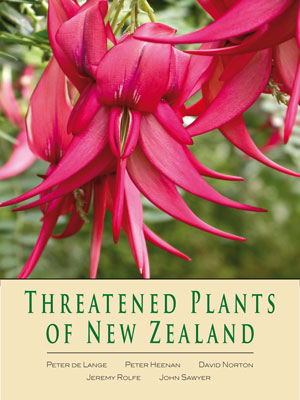184 New Zealand plant species on brink of extinction
Urgent changes in land management policies and practices are needed if the rapid decline in native plant species is to be halted. That’s the conclusion drawn by the NZ Plant Conservation Network in a new book launched today by Minister of Conservation Kate Wilkinson.
Threatened Plants of New Zealand, published by Canterbury University Press, is a project of the NZ Plant Conservation Network (NZPCN) and highlights a dramatic decline in New Zealand’s native plants.

Buy this book online: Threatened Plants of New Zealand
“There’s been a staggering sixty percent increase in the number of critically threatened species in the last five years,” said Network President Philippa Crisp. “There are now 184 species threatened, with more than ninety of those on the brink of extinction, including garden favourites such as two species of kakabeak and the Chatham Island forget-me-not.
“Practically all indicators we use to monitor the state of New Zealand’s environment are showing a looming biodiversity crisis” said Dr Crisp. “Unfortunately, New Zealanders believe that the environment is in good condition but this could not be farther from the truth – our native plants are heading for extinction.”
Dr Crisp said that as politicians discuss mining New Zealand’s national parks and softening the Resource Management Act to speed up development, the government’s focus should turn instead towards changing legislation to protect indigenous plants. Many of the threatened species have no protection at all, as they are on private land, she said.
“Territorial land management agencies must be given legislation, policies and guidelines to support them to more effectively protect the country’s natural heritage from further decline.”
The book Threatened Plants of New Zealand was authored by plant scientists from the Department of Conservation, Landcare Research and University of Canterbury and was sponsored by MWH (a private environmental and engineering company) and the Department of Conservation.
Canterbury University Press, Press Release
New book puts spotlight on New Zealand’s threatened plants
4 March 2010
With one in 13 of New Zealand’s native plants threatened with extinction, the authors of a new book hope to make Kiwis more aware of their plight.
Threatened Plants of New Zealand, published by Canterbury University Press, is a comprehensive, up-to-date account of New Zealand’s six extinct and 184 severely threatened native flora.
Combining precise botanical descriptions with lavish illustrations, the book provides an assessment of the degree of risk to each species, gives an explanation of the nature of those risks, looks at current conservation strategies and provides the characteristics of each plant for identification in the field. The book also includes distribution maps to show where the plants can be found and a full glossary of terms.
The plants featured are listed as either Extinct or Threatened under the New Zealand Threat Classification System, which lists native plants, birds and animals according to threat of extinction. Among the plants included in the book is the popular kakabeak, of which only one plant remains in the wild, the Chatham Island forget-me-not, the native hibiscus and the Castle Hill buttercup.
The book, an initiative of the New Zealand Plant Conservation Network (NZPCN), is the work of a team of authors – Dr Peter de Lange, Dr Peter Heenan, Dr David Norton, Jeremy Rolfe and John Sawyer – who have studied New Zealand’s threatened plants extensively.
Dr de Lange, a threatened plant scientist with the Department of Conservation (DOC), said he hoped the book would raise public awareness of the need to protect the country’s threatened flora and better advocate their plight through “a more accessible format than peer-reviewed scientific literature and botanical society newsletters read by a limited number of the already converted”.
He said as Threatened Plants of New Zealand is the first book to showcase the New Zealand Threat Classification System outside DOC literature, it will be of interest to conservation managers, councils and local government bodies as well as schools and universities studying conservation measures and classification systems.
Threatened Plants of New Zealand is also the first book to cover the topic since the publication of a book of the same name, written by Catherine Wilson and David Given, in 1989 said Dr de Lange.
The publication of Threatened Plants of New Zealand was supported by the NZPCN, DOC and by engineering, environmental, technology and management consultancy MWH New Zealand. It will be launched on 25 March at the Department of Conservation in Wellington.
About the authors:
Peter de Lange is a threatened plant scientist with the Department of Conservation, his work focusing on plant taxonomy, genetics, ecology and threat classification systems.
Peter Heenan is a plant taxonomist with Landcare Research and has served on the New Zealand Threatened Plant Panel since 1999.
David Norton is a botanist and ecologist who heads the Rural Ecology Research Group in the New Zealand School of Forestry at the University of Canterbury.
John Sawyer is a plant ecologist who has worked for the Department of Conservation for 16 years, focusing on the conservation of threatened plants. He is secretary of the New Zealand Plant Conservation Network.
Jeremy Rolfe is a botanist with a strong interest in threatened plants, native orchids and botanical photography. He has worked as a botanical photographer at the Department of Conservation since 1987.
- Threatened Plants of New Zealand by Peter de Lange, Peter Heenan, David Norton, Jeremy Rolfe and John Sawyer, published by Canterbury University Press, March 2010, RRP NZ$99.95, hardback, 472pp, ISBN 978-1-877257-56-8

